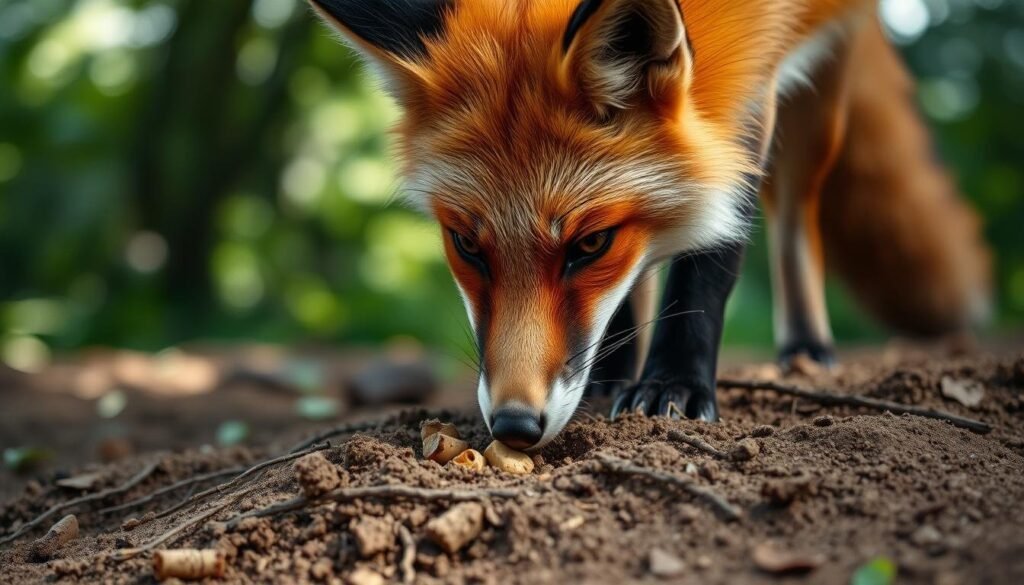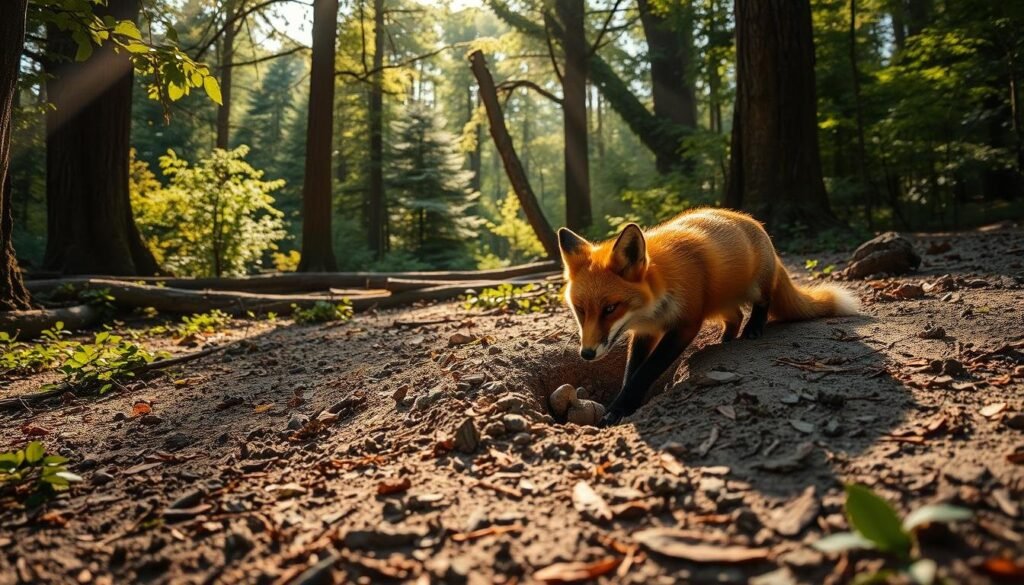Why Do Foxes Bury Food Remains in Soil? You might have seen foxes burying their leftovers. This is called caching, a key part of their survival plan.
Foxes don’t eat all their prey at once. They bury the food remains in soil or under plants. This way, they can eat it later when food is hard to find.
This caching behavior shows how clever and adaptable foxes are. Their method of storing food remains in soil is just one of the many interesting things about them.
Contents
- 1 The Natural Food Caching Behavior of Foxes
- 2 Why Do Foxes Bury Food Remains in Soil?
- 3 The Science Behind Food Caching
- 4 Food Caching Across Different Fox Species
- 5 Seasonal Variations in Fox Food Burying Habits
- 6 Fox Food Caching and Human Interactions
- 7 Conclusion: Why Do Foxes Bury Food Remains in Soil?
- 8 FAQ
- 8.1 Why do foxes bury food remains in soil?
- 8.2 What kind of soil do foxes prefer for burying food?
- 8.3 How do foxes remember where they have cached their food?
- 8.4 Do all fox species exhibit food caching behavior?
- 8.5 How do seasonal changes affect foxes’ food caching habits?
- 8.6 Can foxes cache food in human-modified environments, such as gardens or yards?
- 8.7 How can you identify a fox food cache site?
- 8.8 Are there any safety considerations when dealing with fox food cache sites?
- 8.9 How can humans respect foxes’ food caching behavior?
The Natural Food Caching Behavior of Foxes
Did you know that foxes bury food as part of their natural behavior? This is called food caching. It’s a key survival strategy, especially when food is hard to find or only available at certain times.
Common Signs of Fox Burial Sites
Fox burial sites show up as small depressions in the ground. You might also see loose soil or food and fur remains nearby. These signs mean a fox has buried food there.
Foxes dig a hole, put the food in, and cover it with soil and leaves. They remember where they buried it so they can find it later. [Why Do Foxes Bury Food Remains in Soil?]
Preferred Soil Types and Locations
Foxes like digging in well-drained, loose soil. They often choose spots like woodland edges, fields, and even backyards for their caches.
Distance Patterns from Dens
The distance between a fox’s den and its food caches varies. Foxes usually bury food a few hundred feet away. But, they can cache food up to a mile away if food is plentiful and the spot is safe.
Why Do Foxes Bury Food Remains in Soil?
Foxes bury food in soil for several reasons. This behavior, called caching, is vital for their survival. It’s influenced by many factors. [Why Do Foxes Bury Food Remains in Soil?]
By burying food, foxes make emergency reserves. These reserves are lifesaving during hard times or bad weather. They ensure foxes have food when hunting is tough.
Evolutionary Advantages of Caching
Caching gives foxes evolutionary advantages. It helps them survive in places where food is not always available. This skill has been passed down through generations, improving their survival chances.
Hiding Food from Other Predators
Burying food also keeps it safe from other predators and competitors. By hiding their food, foxes protect their food from being stolen. This way, they keep their nutritional resources safe.
Reducing Scent Trails for Prey
Moreover, caching reduces fox scent trails. This makes it harder for prey to find them. It helps foxes hunt better, as prey animals are less likely to avoid areas where foxes have been.
In short, foxes bury food in soil as a survival strategy. It includes making emergency food reserves, gaining evolutionary benefits, hiding food, and reducing scent trails. This shows how smart and adaptable foxes are in their natural habitats.
The Science Behind Food Caching
To understand food caching, we must explore the cognitive and physiological aspects. You might be curious about how foxes remember where they cached food. This complex process involves several key factors.
Cognitive Mapping Abilities
Foxes create mental maps of their territory. They include the spots where they cached food. This skill helps them remember where they hid food with great accuracy.
Memory Duration for Cache Locations
How long foxes remember where they cached food is crucial. They can recall these spots for months, sometimes even years after they cached it.
Temperature regulation is key to keeping cached food fresh. By burying food, foxes use the earth’s natural temperature. This keeps food cool in summer and warm in winter.
Natural Preservation Mechanisms
Caching food also uses natural preservation mechanisms. The soil protects the food from the elements and predators. This helps keep the food fresh for longer.
- Cognitive mapping enables foxes to recall cache locations.
- Memory duration allows for long-term recall of cache sites.
- Temperature regulation helps preserve the quality of cached food.
- Natural preservation mechanisms protect cached food from predators and environmental factors.
By learning about these scientific principles, we can better understand food caching in foxes. [Why Do Foxes Bury Food Remains in Soil?]
Food Caching Across Different Fox Species
Did you know that different fox species have their own ways of storing food? This behavior is common among foxes, but each species has its own twist. These differences show how they’ve adapted to their surroundings.
The red fox is a master at hiding food, burying it in many places. On the other hand, the Arctic fox stores food in fewer spots but in bigger amounts. This is because food is scarce in its cold home.
| Fox Species | Caching Frequency | Typical Cache Size |
|---|---|---|
| Red Fox | High | Small to Medium |
| Arctic Fox | Moderate | Large |
| Fennec Fox | Low | Small |
Learning about these differences helps us see how foxes have developed unique survival strategies. By looking at how different fox species cache food, we can understand their adaptability and strength.
Seasonal Variations in Fox Food Burying Habits
Did you know foxes change how they bury food with the seasons? This is because they need to survive. As the weather changes, so do their ways of storing and finding food.
In the fall, foxes bury extra food to get ready for winter. This is key for them to survive when food is scarce. [Why Do Foxes Bury Food Remains in Soil?]
Winter Retrieval Patterns
In winter, foxes use their memory and smell to find the food they cached. How well they can find it depends on the winter’s harshness and if there’s other food around.
Weather Influences on Caching Decisions
Weather plays a big role in where foxes bury food. Cold weather makes them bury more to survive. But if it’s mild, they might not bury as much because food is easier to find.
Habitat Changes and Adaptation
Foxes adjust how they bury food when their habitat changes. This could be because of humans or natural events. Being able to change their ways helps them survive in different places.
- Foxes adjust their food burying habits seasonally.
- Fall is a critical period for surplus hoarding.
- Weather conditions influence caching decisions.
- Habitat changes require foxes to adapt their caching behaviors.
Fox Food Caching and Human Interactions
Human activity and fox behavior meet in interesting ways. This is especially true in gardens and yards. As cities grow, so do the chances of seeing foxes.

Foxes often hide food in gardens and yards. This is because they’ve learned to live in cities. [Why Do Foxes Bury Food Remains in Soil?]
Human Food Sources and Caching Changes
Having food from humans changes how foxes cache food. They might change their caching ways if they can get food easily from people.
| Factor | Influence on Caching |
|---|---|
| Human Food Availability | Increases caching in residential areas |
| Natural Food Scarcity | May increase reliance on cached food |
Identification and Safety Considerations
Finding where foxes cache food needs care. Look for signs like disturbed soil or hidden food. But keep a safe distance.
Respecting Wildlife Behaviors
It’s important to respect foxes and their ways. Letting them do their thing helps us all live together better. [Why Do Foxes Bury Food Remains in Soil?]
Conclusion: Why Do Foxes Bury Food Remains in Soil?
You’ve learned about foxes burying food in soil, called food caching. This behavior helps them survive when food is scarce. It’s backed by scientific research.
Different fox species have unique caching habits. Seasonal changes also affect their behavior. Understanding these patterns shows how adaptable and resilient foxes are.
Studying foxes’ caching behavior reveals their fascinating nature. It also shows why we must respect wildlife habits. By understanding their relationship with their environment, we can better protect these ecosystems.
See Also: Discover Why Raccoons Wash Their Food Before Eating
FAQ
Why do foxes bury food remains in soil?
Foxes bury food to keep it safe for later. It helps them hide it from other animals. It also makes it harder for prey to find them.
What kind of soil do foxes prefer for burying food?
Foxes like soil that’s easy to dig. They prefer sandy or loamy soil for this. [Why Do Foxes Bury Food Remains in Soil?]
How do foxes remember where they have cached their food?
Foxes use their memory to find their food. They can remember where they buried it for a long time.
Do all fox species exhibit food caching behavior?
Many fox species bury food. But how often and how they do it can differ. [Why Do Foxes Bury Food Remains in Soil?]
How do seasonal changes affect foxes’ food caching habits?
Foxes bury more food in the fall. They then dig it up in winter when food is hard to find.
Can foxes cache food in human-modified environments, such as gardens or yards?
Yes, foxes can bury food in places like gardens and yards. They do this if they feel safe and there’s plenty of food.
How can you identify a fox food cache site?
Look for signs like dug-up soil and hidden food. You might also see disturbed plants.
Are there any safety considerations when dealing with fox food cache sites?
Yes, be careful around fox food caches. They might attract other animals or pets. [Why Do Foxes Bury Food Remains in Soil?]
How can humans respect foxes’ food caching behavior?
Don’t disturb fox food caches. Keep pets away. And don’t feed foxes or other wildlife on purpose.

Zyair Larson, based in Denver, Colorado, has over 12 years of experience studying animal behavior. He has worked with the World Wildlife Fund (WWF) and National Geographic, researching wildlife and sharing insights on animal habits globally.

